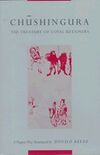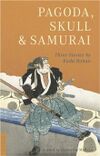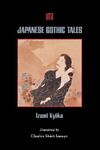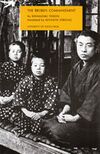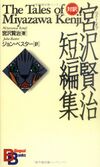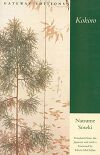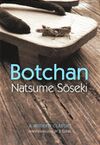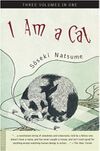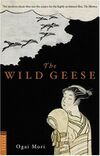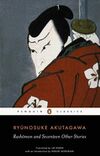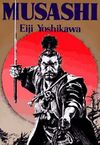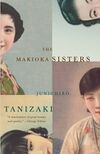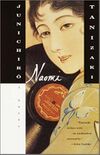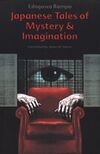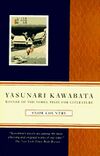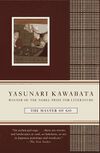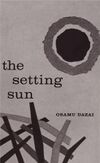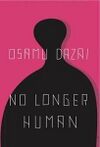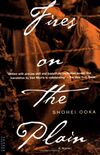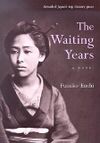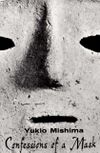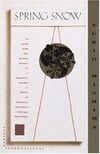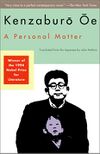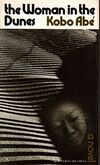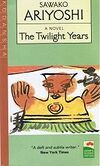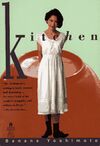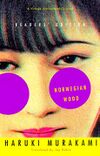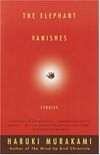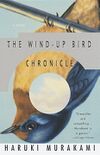Japanese: Difference between revisions
From /lit/ Wiki
Jump to navigationJump to search
imported>Sriq No edit summary |
imported>Ukodus |
||
| (4 intermediate revisions by 2 users not shown) | |||
| Line 11: | Line 11: | ||
| style="text-align: center;"|974 | | style="text-align: center;"|974 | ||
| | | | ||
| | |[[File:The_Gossamer_Years.jpg|thumb|98px]] | ||
|- | |- | ||
| style="text-align: center;"|The Pillow Book | | style="text-align: center;"|The Pillow Book | ||
| Line 17: | Line 17: | ||
| style="text-align: center;"|1002 | | style="text-align: center;"|1002 | ||
| | | | ||
| | |[[File:The_Pillow_Book.jpg|thumb|98px]] | ||
|- | |- | ||
| style="text-align: center;"|The Tale of Genji | | style="text-align: center;"|The Tale of Genji | ||
| Line 23: | Line 23: | ||
| style="text-align: center;"|1021 | | style="text-align: center;"|1021 | ||
| | | | ||
| | |[[File:The_Tale_Of_Genji.jpg|thumb|98px]] | ||
|- | |- | ||
| style="text-align: center;"|The Tales of Ise | | style="text-align: center;"|The Tales of Ise | ||
| Line 29: | Line 29: | ||
| style="text-align: center;"|~ | | style="text-align: center;"|~ | ||
| | | | ||
| | |[[File:The_Tales_Of_Ise.jpg|thumb|98px]] | ||
|- | |- | ||
| style="text-align: center;"|Hojoki | | style="text-align: center;"|Hojoki | ||
| Line 35: | Line 35: | ||
| style="text-align: center;"|1212 | | style="text-align: center;"|1212 | ||
| | | | ||
| | |[[File:Hojoki.jpg|thumb|98px]] | ||
|- | |- | ||
| style="text-align: center;"|Essays in Idleness | | style="text-align: center;"|Essays in Idleness | ||
| Line 41: | Line 41: | ||
| style="text-align: center;"|1330 | | style="text-align: center;"|1330 | ||
| | | | ||
| | |[[File:Essays_In_Idleness.jpg|thumb|98px]] | ||
|- | |- | ||
| style="text-align: center;"|The Tale of Heike | | style="text-align: center;"|The Tale of The Heike | ||
| style="text-align: center;"|Anonymous | | style="text-align: center;"|Anonymous | ||
| style="text-align: center;"|1371 | | style="text-align: center;"|1371 | ||
| | | | ||
| | |[[File:The_Tale_Of_The_Heike.jpg|thumb|98px]] | ||
|} | |} | ||
| Line 232: | Line 232: | ||
==='''Post War (1946 - present)'''=== | ==='''Post War (1946 - present)'''=== | ||
{| border="1" cellpadding="1" cellspacing="1" style="width: | {| border="1" cellpadding="1" cellspacing="1" style="width: 800px;" | ||
| style="text-align: center;"|'''Title''' | | style="text-align: center;"|'''Title''' | ||
| style="text-align: center;"|'''Author''' | | style="text-align: center;"|'''Author''' | ||
| style="text-align: center;"|'''Year''' | | style="text-align: center;"|'''Year''' | ||
| style="text-align: center;"|'''Pages''' | | style="text-align: center;"|'''Pages''' | ||
| style="text-align: center;"|'''Description''' | | style="text-align: center; width: 500px"|'''Description''' | ||
| style="text-align: center;"|'''Cover''' | | style="text-align: center;"|'''Cover''' | ||
|- | |- | ||
| style="text-align: center;"|The Counterfeiter and Other Stories | | style="text-align: center;"|The Counterfeiter and Other Stories | ||
| style="text-align: center;"|Yasushi Inoue | | style="text-align: center;"|Yasushi Inoue | ||
| | | style="text-align: center;"|~ | ||
| | | style="text-align: center;"|124 | ||
| | |"In ''The Counterfeiter'', a writer is commissioned to write the biography of a famous painter but becomes fascinated by a man who produced forgeries of the artist's work. ''Obasute'' concerns a man's obsession with a legend of old women being taken to a mountain and abandoned, and his interpretation of the actions of the members of his family in light of this legend. '' The Full Moon'' is a story of company politics, particularly the rise and fall of the firm's president, told largely through incidents at annual company parties." | ||
| | |[[File:The_Counterfeiter_and_Other_Stories.jpg|center|100px]] | ||
|- | |- | ||
| style="text-align: center;"|Snow Country | | style="text-align: center;"|Snow Country | ||
| style="text-align: center;"|Yasunari Kawabata | | style="text-align: center;"|Yasunari Kawabata | ||
| style="text-align: center;"|1947 | | style="text-align: center;"|1947 | ||
| | | style="text-align: center;"|192 | ||
| | |"To this haunting novel of wasted love, Kawabata brings the brushstroke suggestiveness and astonishing grasp of motive that earned him the Nobel Prize for Literature. As he chronicles the affair between a wealthy dilettante and the mountain geisha who gives herself to him without illusions or regrets, one of Japan's greatest writers creates a work that is dense in implication and exalting in its sadness." | ||
|[[File:Snow_Country.jpg|center|100px]] | |[[File:Snow_Country.jpg|center|100px]] | ||
|- | |- | ||
| Line 257: | Line 257: | ||
| style="text-align: center;"|Yasunari Kawbata | | style="text-align: center;"|Yasunari Kawbata | ||
| style="text-align: center;"|~ | | style="text-align: center;"|~ | ||
| | | style="text-align: center;"|280 | ||
| | |"<span id="freeText16816397008742319568" style="">Recipient of the Nobel Prize in Literature in 1968, the novelist Yasunari Kawabata felt the essence of his art was to be found not in his longer works but in a series of short stories--which he called "Palm-of-the-Hand Stories"--written over the span of his career. In them we find loneliness, love, and the passage of time, demonstrating the range and complexity of a true master of short fiction."</span> | ||
|[[File: | |[[File:Palm_Of_The_Hand_Stories.jpg|thumb|98px]] | ||
|- | |- | ||
| style="text-align: center;"|The Master of Go | | style="text-align: center;"|The Master of Go | ||
| style="text-align: center;"|Yasunari Kawabata | | style="text-align: center;"|Yasunari Kawabata | ||
| style="text-align: center;"|1954 | | style="text-align: center;"|1954 | ||
| | | style="text-align: center;"|208 | ||
| | |"Go is a game of strategy in which two players attempt to surround each other's black or white stones. Simple in its fundamentals, infinitely complex in its execution, it is an essential expression of the Japanese sensibility. And in his fictional chronicle of a match played between a revered and invincible Master and a younger, more progressive challenger, Yasunari Kawabata captured the moment in which the immutable traditions of imperial Japan met the onslaught of the twentieth century." | ||
|[[File:The_Master_of_Go.jpg|center|100px]] | |[[File:The_Master_of_Go.jpg|center|100px]] | ||
|- | |- | ||
| Line 271: | Line 271: | ||
| style="text-align: center;"|Osamu Dazai | | style="text-align: center;"|Osamu Dazai | ||
| style="text-align: center;"|1947 | | style="text-align: center;"|1947 | ||
| | | style="text-align: center;"|175 | ||
| | |"Set in the early postwar years, it probes the destructive effects of war and the transition from a feudal Japan to an industrial society. The narrator is Kazuko, a young woman born to gentility but now impoverished. Though she wears Western clothes, her outlook is Japanese; her life is static, and she recognizes that she is spiritually empty. In the course of the novel she survives the deaths of her aristocratic mother and her sensitive, drug-addicted brother Naoji, an intellectual ravaged by his own and by society's spiritual failures." | ||
|[[File:The_Setting_Sun.jpg|center|100px]] | |[[File:The_Setting_Sun.jpg|center|100px]] | ||
|- | |- | ||
| Line 278: | Line 278: | ||
| style="text-align: center;"|Osamu Dazai | | style="text-align: center;"|Osamu Dazai | ||
| style="text-align: center;"|1948 | | style="text-align: center;"|1948 | ||
| | | style="text-align: center;"|177 | ||
| | |"Osamu Dazai's No Longer Human narrates a seemingly normal life even while the protagonist feels himself incapable of understanding human beings.Yozo's attempts to reconcile himself to the world around him begin in early childhood, continue through high school, where he becomes a "clown" to mask his alienation, and eventually lead to a failed suicide attempt as an adult. Without sentimentality, he records the casual cruelties of life and its fleeting moments of human connection and tenderness." | ||
|[[File:No_Longer_Human.jpg|center|100px]] | |[[File:No_Longer_Human.jpg|center|100px]] | ||
|- | |- | ||
| style="text-align: center;"|Fires on the Plain | |||
| style="text-align: center;"|Fires on the Plain | | style="text-align: center;"|Shohei Ooka | ||
| | | style="text-align: center;"|1951 | ||
| style="text-align: center;"|1951 | | style="text-align: center;"|248 | ||
| | |"This haunting novel explores the complete degradation and isolation of a man by war. Set on a Philippine island during World War II where the Japanese army is disintegrating under the blows of the American forces landings, Private Tamura's own private battles cost him first his hope and then his sanity as he loses his own tenuous ties with human society." | ||
| | |[[File:Fires_on_the_Plain.jpg|center|100px]] | ||
| | |||
|- | |- | ||
| style="text-align: center;"|The Waiting Years | | style="text-align: center;"|The Waiting Years | ||
| Line 316: | Line 315: | ||
| | | | ||
| | | | ||
| | |[[File:Spring_Snow.jpg|center|100px]] | ||
|- | |- | ||
| style="text-align: center;"|Nip the Buds, Shoot the Kids | | style="text-align: center;"|Nip the Buds, Shoot the Kids | ||
| Line 323: | Line 322: | ||
| | | | ||
| | | | ||
| | |[[File:Nip_the_Buds,_Shoot_the_Kids.jpg|center|100px]] | ||
|- | |- | ||
| style="text-align: center;"|A Personal Matter | | style="text-align: center;"|A Personal Matter | ||
| Line 372: | Line 371: | ||
| | | | ||
| | | | ||
| | |[[File:The_Twilight_Years.jpg|center|100px]] | ||
|- | |- | ||
| style="text-align: center;"|Almost Transparent Blue | | style="text-align: center;"|Almost Transparent Blue | ||
| Line 379: | Line 378: | ||
| | | | ||
| | | | ||
| | |[[File:Almost_Transparent_Blue.jpg|center|100px]] | ||
|- | |- | ||
| style="text-align: center;"|Kitchen | | style="text-align: center;"|Kitchen | ||
| Line 400: | Line 399: | ||
| | | | ||
| | | | ||
| | |[[File:The_Elephant_Vanishes.jpg|center|100px]] | ||
|- | |- | ||
| style="text-align: center;"|The Wind-Up Bird Chronicle | | style="text-align: center;"|The Wind-Up Bird Chronicle | ||
| Line 416: | Line 415: | ||
|[[File:The_Housekeeper_and_the_Professor.jpg|center|100px]] | |[[File:The_Housekeeper_and_the_Professor.jpg|center|100px]] | ||
|} | |} | ||
[[Category:Recommended Reading]] | |||










